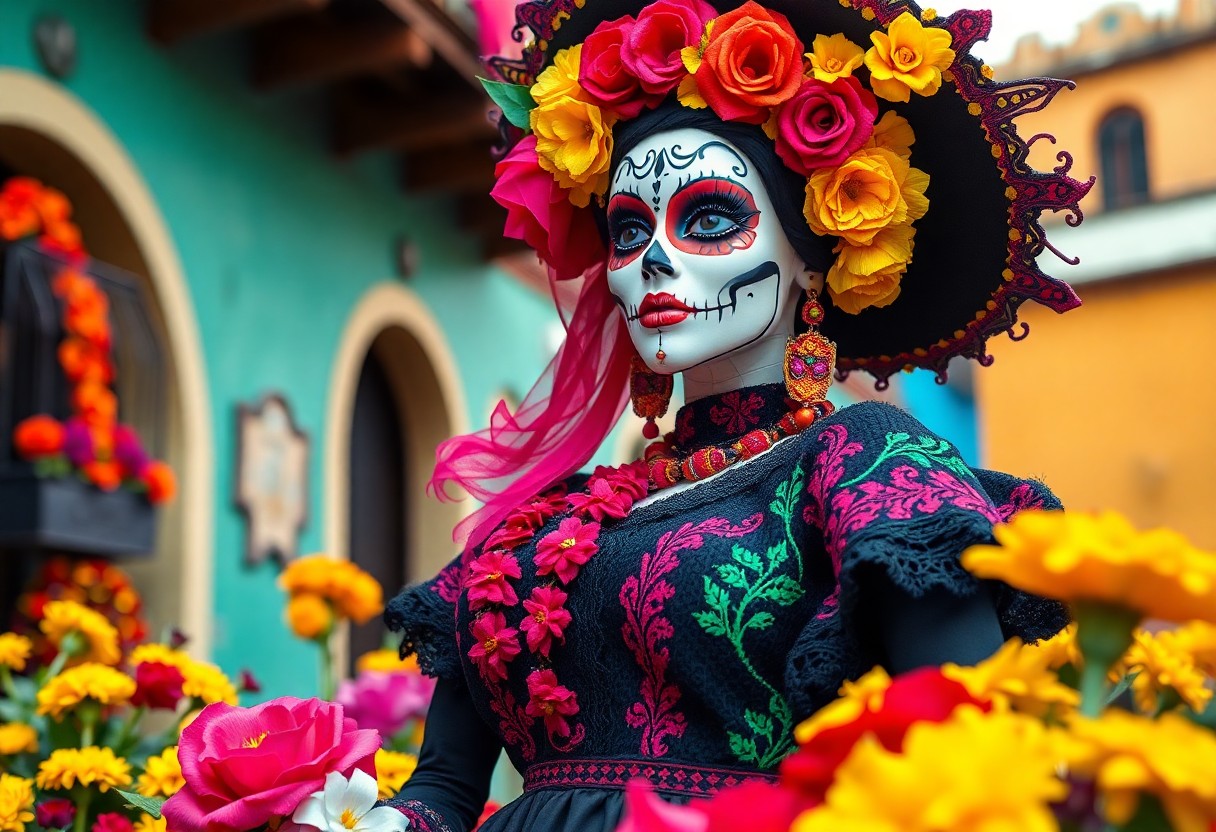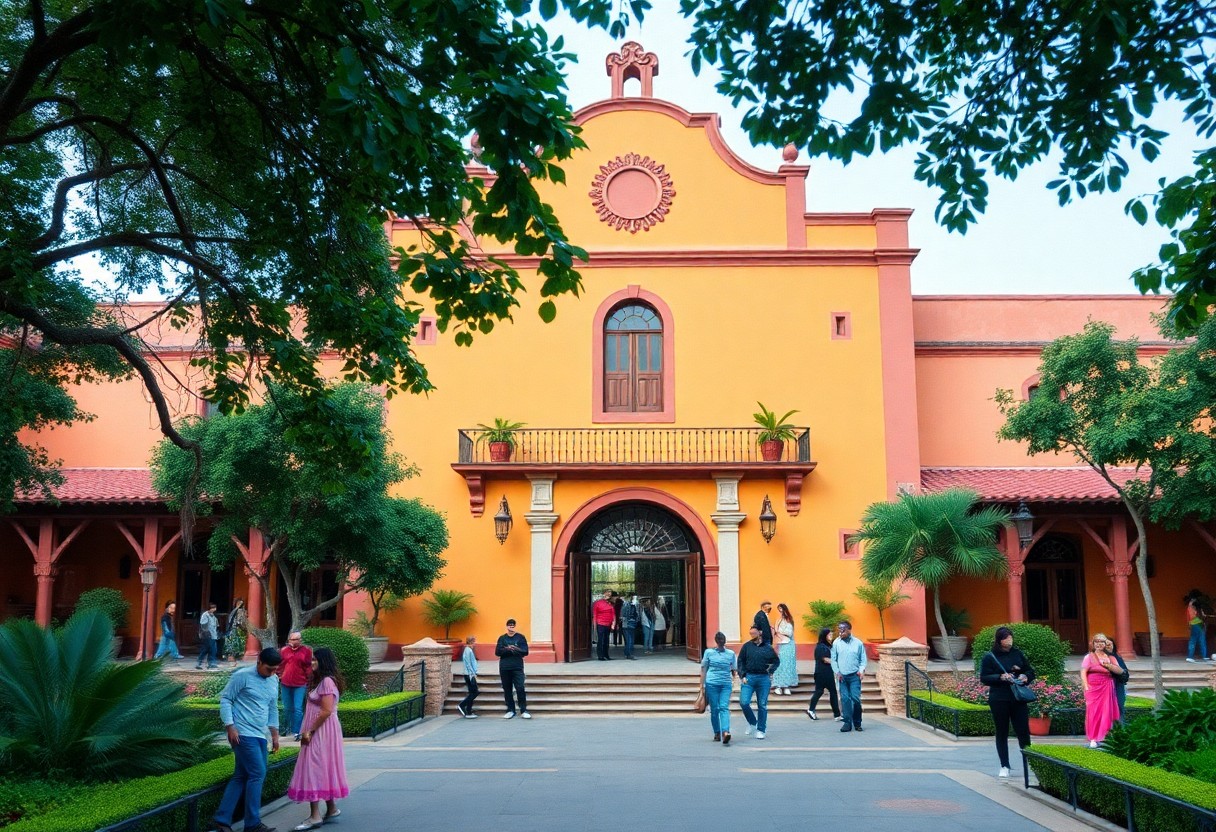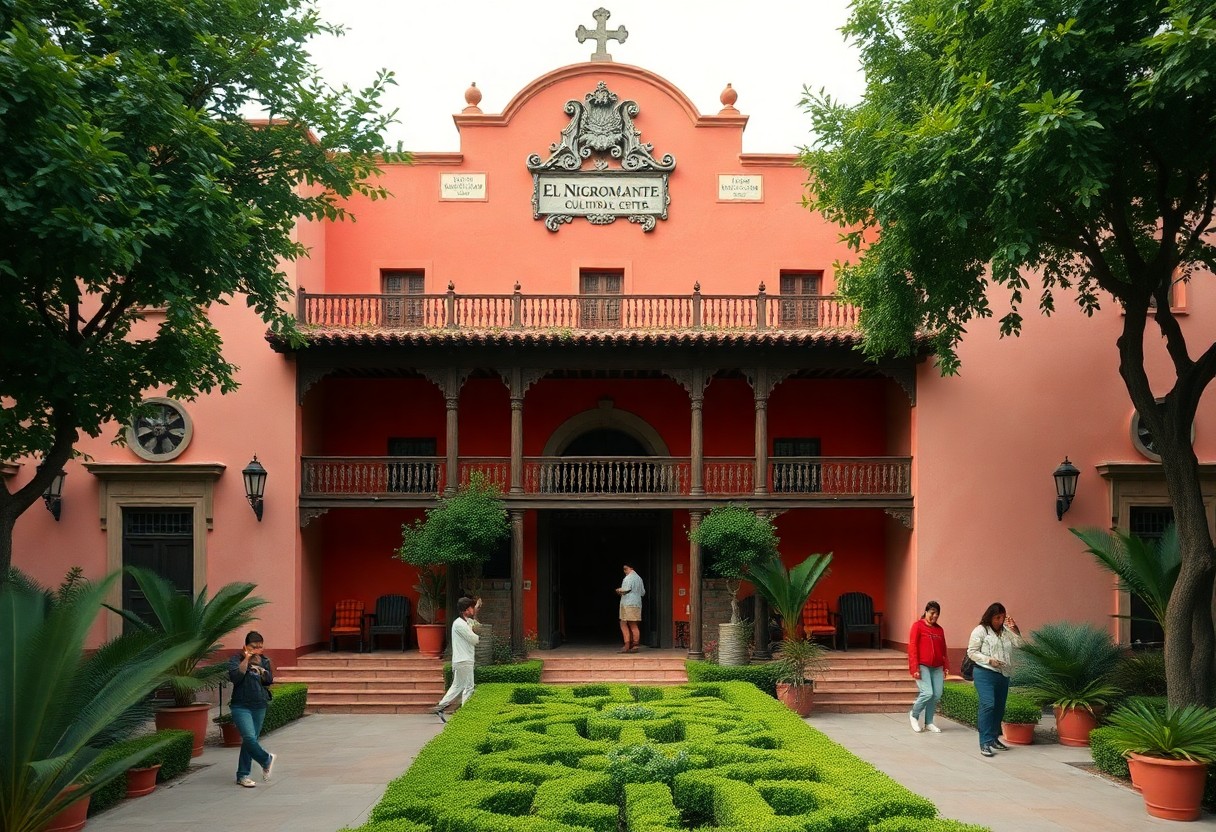During the vibrant festivities of the Day of the Dead, the enchanting town of San Miguel de Allende comes alive with a rich celebration that centers around the iconic figure of La Catrina. This symbol serves as a profound representation of the intricate relationship between life and death, deeply rooted in the rich cultural heritage of Mexico. La Catrina, who was originally conceived in 1910 by the artist José Guadalupe Posada as a satirical commentary on the elite class, has evolved into a beloved cultural icon that embodies the spirit of this celebration. In San Miguel de Allende, her image is omnipresent, found on ofrendas, in exuberant parades, and through artistic face painting, highlighting the Mexican philosophy of embracing death as a natural and integral part of life. Explore the deep connection that La Catrina nurtures between the living and the dead, solidifying her position as a central figure in this important cultural event.
Discovering the Fascinating History of La Catrina: Uncovering Her Cultural Roots
The figure of La Catrina stands as a powerful symbol of both elegance and mortality, with her origins tracing back to 1910. She was initially brought to life as a satirical lithograph by José Guadalupe Posada, who originally named her La Calavera Garbancera. Posada created this figure to critique the upper class of Mexico, who distanced themselves from their indigenous roots in favor of European customs. With her skeletal form adorned with an exquisite hat, La Catrina serves as a poignant reminder that, in death, social hierarchies fade away. This striking imagery has become an integral part of Mexican culture, especially during the Day of the Dead celebrations in lively places like San Miguel de Allende, where her spirit resonates in the hearts of many.
Delving into the Artistic Brilliance of José Guadalupe Posada: The Mind Behind La Catrina
The origins of La Catrina can be linked to the remarkable creativity of José Guadalupe Posada, whose artistic genius gave birth to La Calavera Garbancera. His work was a direct commentary on the Mexican elite, particularly criticizing those who adopted European fashions while neglecting their rich indigenous heritage. The elegant skeletal representation, adorned with fashionable accessories, became a powerful symbol of equality in death, echoing the sentiments of the Mexican populace and the Day of the Dead rituals celebrated in vibrant San Miguel de Allende. Posada’s impactful creations challenge societal norms and inspire reflection on identity and cultural heritage, ensuring that La Catrina remains a relevant figure in modern discussions about social justice.
La Catrina: A Bold Social Commentary on Mexican Society and Mortality
One of the most striking aspects of La Catrina is her role as a social commentator. Posada utilized her image to shed light on the hypocrisy that was rampant among Mexico’s elite during the Porfirio Díaz era, a time marked by stark inequality and widespread corruption. Dressed in European fashion, her skeletal figure serves as a powerful reminder that wealth and status are fleeting in the face of mortality. This critical perspective remains significant in contemporary society, as La Catrina continues to embody the notion of unity among all individuals confronted with the inevitability of death.
By exploring the satirical essence of La Catrina, we uncover how her imagery boldly challenged societal conventions. Posada’s artistic endeavors confronted the corruption and inequality that characterized the Díaz regime, which favored the wealthy while ignoring the plight of the marginalized. Through her portrayal of death as the ultimate equalizer, La Catrina emerged as a poignant symbol for social reflection. Her transformation into a cultural icon, particularly in San Miguel de Allende, emphasizes the enduring relevance of her message, intertwining humor with serious contemplation in the celebration of life and death.
![]()
Diego Rivera’s Artistic Contributions: Elevating La Catrina to Cultural Icon Status
While La Catrina began as a satirical representation, her evolution into a revered cultural icon was significantly influenced by the legendary artist Diego Rivera. Rivera’s artistic vision transformed La Catrina from a critique of societal elitism into a representation of genuine Mexican identity, seamlessly blending indigenous elements with European artistry. His impactful work played a crucial role in establishing La Catrina’s significance in the celebration of Día de los Muertos, intricately linking her to the themes of life, death, and the richness of cultural heritage that define this important event.
Examining Rivera’s Mural “Dream of a Sunday Afternoon in Alameda Park”: Celebrating La Catrina’s Elegance
In 1947, Diego Rivera created an iconic mural titled “Dream of a Sunday Afternoon in Alameda Park,” where La Catrina is prominently featured alongside historical figures and a youthful depiction of the artist himself. This mural not only highlights her elegance and charm but also weaves her into the rich historical narrative and cultural evolution of Mexico. By placing her within this grand tableau, Rivera ensured that La Catrina’s legacy would be one of unity and contemplation regarding mortality, solidifying her status as an enduring figure within Mexican art and culture.
Establishing La Catrina as a Vital Cultural Symbol in Mexican Heritage
The impact of Rivera’s mural was profound, firmly establishing La Catrina as a significant cultural symbol. His artistic portrayal of her within a historical context linked her to the overarching narrative of Mexican identity, transforming her into a source of pride and introspection. Today, La Catrina stands as a representation of the celebration of life and death, encapsulating the spirit of Día de los Muertos in San Miguel de Allende and beyond.
During the celebratory afternoons in San Miguel de Allende, La Catrina often takes center stage, her figure serving as a poignant reminder of the city’s vibrant cultural roots. Her transformation from a satirical entity to a powerful cultural symbol illustrates the resilience of Mexican traditions and the significance of honoring both life and death. Rivera’s mural has enshrined her legacy in history, ensuring that she remains a lasting icon of Mexican heritage and the vibrant festivities of Día de los Muertos.
Understanding La Catrina’s Multifaceted Symbolism: The Essence of Life and Death
La Catrina is widely perceived as a powerful emblem of equality, serving as a poignant reminder that death unifies all individuals, regardless of their social status. She embodies the Mexican acceptance of mortality, artfully blending humor, artistry, and reverence for the life-death continuum. In San Miguel de Allende, her presence during the Day of the Dead festivities underscores the importance of honoring ancestors while celebrating the fleeting beauty of life, reminding everyone of the cyclical nature of existence.
Embracing the Mexican Philosophy on Life and Death Through the Lens of La Catrina
To truly appreciate La Catrina, one must delve into the Mexican perspective on life and death. In Mexican culture, death is not viewed with fear; rather, it is embraced as an intrinsic part of life. This ethos is vividly illustrated in San Miguel de Allende, where colorful altars, pathways adorned with marigolds, and lively gatherings are held to honor those who have passed away. La Catrina serves as a living embodiment of this philosophy, reminding individuals to cherish every moment while acknowledging the inevitability of life’s conclusion.
Exploring the Fusion of Indigenous and European Traditions in La Catrina’s Symbolism
La Catrina exemplifies a unique cultural fusion, rooted in both Aztec and Catholic traditions. The Aztec civilization viewed death as a transition rather than an end, while Catholicism introduced rituals such as All Saints’ Day to the cultural landscape. In San Miguel de Allende, this amalgamation is prevalent in ofrendas, where marigolds, candles, and photographs of loved ones create a bridge connecting the living with the deceased.
The vibrant essence of life in San Miguel de Allende during the Día de los Muertos serves as a testament to this cultural blend. Marigolds, known as Cempasúchil, are believed to guide spirits back to the living realm, while pan de muerto and sugar skulls symbolize the sweetness and richness of life. La Catrina occupies a central role in these traditions, embodying the harmonious relationship between indigenous and European influences. Her existence serves as a reminder that death is not the end but an extension of the life’s journey that we all share.
![]()
La Catrina’s Central Role in the Lively Celebrations of San Miguel de Allende
Unlike other regions, San Miguel de Allende celebrates La Catrina as a dynamic symbol of its Day of the Dead festivities. Her iconic figure is prominently featured in parades, artistic displays, and face painting, highlighting the vibrant fusion of tradition and creativity that characterizes this UNESCO World Heritage city. La Catrina’s presence amplifies the unique charm of San Miguel de Allende, fostering connections between locals and visitors while deepening their appreciation for the profound themes of life, death, and remembrance that define this festival.
Recognizing La Catrina’s Integral Role in Day of the Dead Celebrations
On the Day of the Dead, La Catrina emerges as a vital link between the living and the deceased in San Miguel de Allende. You will find her guiding processions, adorning altars, and inspiring elaborate costumes. Her elegant yet skeletal form serves as a reminder that death should not evoke fear, but rather be celebrated as a natural part of life’s journey. In San Miguel de Allende, she embodies the joy, humor, and reverence that define this cherished tradition, inviting all to partake in the festivities.
Experiencing the Richness of Ofrendas, Pan de Muerto, and Marigold Flowers in San Miguel de Allende
If you visit San Miguel de Allende during the Day of the Dead, you will encounter beautifully crafted ofrendas adorned with pan de muerto and marigold flowers, both essential components of this significant celebration. These offerings are designed to honor the memories of loved ones, with the sweet bread symbolizing the joys of life, while the marigolds, with their vibrant colors and fragrant aroma, guide spirits back to the living. Together, these elements create a sensory experience that connects you to the spiritual essence of this festival.
The vibrant celebrations in San Miguel de Allende would be incomplete without these cherished traditions. The ofrendas are intricately designed, often featuring photographs, candles, and favorite foods of those who have passed. The pan de muerto, characterized by its unique shape and delightful flavor, is a staple found in every home and marketplace. The marigold flowers, known locally as cempasúchil, are believed to illuminate the path for returning spirits. These elements blend harmoniously to create a visually stunning and deeply meaningful celebration that honors the cycle of life.
![]()
The Evolution of La Catrina’s Meaning: From Satire to Cultural Icon
It is vital to recognize that La Catrina’s meaning has dramatically evolved over time. Initially conceived as a satirical figure critiquing the elite, she has blossomed into a beloved representation of Día de los Muertos. Today, she symbolizes the delicate balance between life and death, beautifully merging humor, aesthetics, and cultural pride. In San Miguel de Allende, her presence during Day of the Dead festivities emphasizes her role as a unifying figure, connecting individuals to their heritage and the cherished memories of loved ones who have departed.
Tracing the Remarkable Journey: La Catrina’s Transformation from Satire to Celebration
The metamorphosis of La Catrina from a satirical representation to a celebratory icon epitomizes her profound cultural significance. Created by José Guadalupe Posada as a means to mock the elite, she was later redefined by Diego Rivera to embody the essence of Mexican identity. In San Miguel de Allende, her image now adorns ofrendas and parades, celebrating the intertwining of life and death with vibrant colors and spirited festivities that resonate deeply with all who participate.
La Catrina: A Significant Symbol of Unity and Remembrance in Mexican Culture
At the core of La Catrina’s role in San Miguel de Allende is the essence of remembrance. She serves as a bridge that connects the living and the departed, encouraging individuals to honor their ancestors while joyfully celebrating their lives. Her presence during Día de los Muertos fosters a sense of unity as communities come together to create ofrendas, share stories, and recognize the cycle of life and death that binds us all.
This profound symbolism is deeply embedded within the traditions of San Miguel de Allende. La Catrina’s graceful figure, often adorned with marigolds and flickering candles, guides spirits back to the realm of the living during the Day of the Dead. Her role in uniting families and communities serves as a powerful reminder of the importance of honoring cultural heritage. By participating in these celebrations, you not only pay homage to the deceased but also reinforce your connection to Mexican traditions and values.
The Lasting Impact of La Catrina on Contemporary Art and Culture
Your fascination with La Catrina transcends her historical origins, as she continues to inspire contemporary art and culture across the globe. Her iconic skeletal form, adorned with elaborate attire, has become a muse for artists, designers, and creators worldwide. In San Miguel de Allende, her influence is especially pronounced during the Day of the Dead, where her image is reinterpreted in murals, sculptures, and even fashion. La Catrina’s unique blend of satire and beauty resonates deeply, serving as a reminder of universal truths regarding life, death, and the concept of equality.
The Enduring Influence of La Catrina on Modern Artistic Expression
La Catrina’s impact on modern artists is remarkable, as her image has been reinterpreted across countless mediums, from vibrant street art to high-fashion collections. Within the creative community of San Miguel de Allende, local artists frequently incorporate her likeness into their works of art, merging traditional motifs with contemporary styles. Her skeletal representation serves as a canvas for artistic expression, allowing creators to explore themes of mortality, identity, and cultural heritage. Through their artistry, they ensure her legacy remains vibrant while imbuing her image with new layers of meaning and significance.
La Catrina’s Global Recognition During Celebrations Around the World
The influence of La Catrina transcends cultural boundaries, establishing her as a worldwide symbol of the Día de los Muertos celebration. From parades in New York to festivals in Tokyo, her image resonates with people across the globe. In San Miguel de Allende, her presence is particularly impactful, drawing visitors from all corners of the earth to partake in the lively festivities. The universal appeal of La Catrina lies in her ability to connect individuals through shared themes of life, death, and remembrance that resonate with all cultures.
To fully comprehend La Catrina’s global significance, one need only observe her role in international celebrations. Her image has become a unifying symbol, bridging diverse cultures and traditions. In San Miguel de Allende, her prominence during the Día de los Muertos showcases the city’s rich cultural heritage and attracts thousands of tourists each year. However, her widespread popularity also carries the responsibility of preserving her cultural essence. Misinterpretations or commercialization risk diluting her meaning, making it imperative to honor her roots while embracing her global resonance.
Embracing La Catrina’s Legacy: A Cultural Reflection of Mexican Heritage
As you conclude this in-depth exploration of La Catrina, you gain valuable insights into her significance as a cultural icon within San Miguel de Allende. Her transformation from a satirical figure to a symbol of unity, humor, and reverence for life and death reflects the intricate tapestry of Mexican heritage. During the Day of the Dead festivities, her presence in San Miguel de Allende connects you to a rich history, tradition, and celebration that resonates deeply with many. By honoring La Catrina, you embrace the Mexican perspective on mortality, viewing death not with fear, but as a natural facet of existence that should be celebrated. Allow her elegance and powerful symbolism to inspire you to treasure life and honor those who have come before you.
Your Questions Answered: Frequently Asked Questions about La Catrina
Who is La Catrina’s creator and what motivated her inception?
La Catrina was created by José Guadalupe Posada in 1910. He designed her as a satirical lithograph titled La Calavera Garbancera, aimed at critiquing Mexico’s elite society. Through her skeletal figure and stylish hat, Posada mockingly illustrated the concept that death renders everyone equal, regardless of their social standing.
How did Diego Rivera enhance La Catrina’s prominence within Mexican culture?
Diego Rivera elevated La Catrina’s status through his 1947 mural, “Dream of a Sunday Afternoon in Alameda Park.” In this mural, La Catrina is depicted alongside Rivera and other notable historical figures, solidifying her place as a lasting emblem of Mexican culture and linking her to the celebrations of Día de los Muertos.
What significance does La Catrina hold in the Day of the Dead celebrations in San Miguel de Allende?
In San Miguel de Allende, La Catrina plays a pivotal role during the Day of the Dead festivities. She is prominently featured in face paintings, statues, and ofrendas. These beautifully decorated altars are adorned with pan de muerto, marigold flowers, and other offerings to honor deceased loved ones. The presence of La Catrina infuses the celebration with joy and significance, harmonizing humor and reverence for the cycles of life and death that connect us all.
The Article: The Story of La Catrina: A Cultural Icon of Day of the Dead in San Miguel de Allende appeared first on https://fallinginlovewithsanmiguel.com/
The Article La Catrina: Celebrating a Day of the Dead Icon in San Miguel Was Found On https://limitsofstrategy.com



